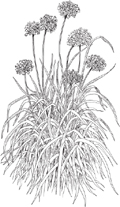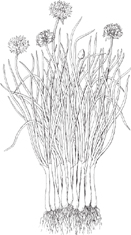
The chive is a hardy perennial herb that grows in clusters of many small, oniony bulbs. Take a close look and you’ll notice that this herb’s leaves are long, thin, cylindrical spikes, hollow on the inside, with a bright, medium-green hue. In late spring, chives produce pompomlike blossoms in varying shades. At maturity, the plants reach heights of 8 to 18 inches (30–45 cm), depending on the variety and growing conditions.
Chives can be found in several varieties in herb and vegetable gardens across Europe, Asia, and North America. They grow wild in the Mediterranean, tucked into moist soil pockets on hillsides and cliff walks by the sea. All are grown and harvested in much the same manner. One way to distinguish among the different species and varieties is to examine the color of their flowers, which range from dark pink through pastel shades to medium purple.
In North America, the most common species is Allium schoenoprasum, known as garden chives, which have long, hollow, cylindrical leaves and striking clusters of globe-shaped pinkish purple flowers. In Asia, however, A. tuberosum, or garlic chives, remain the favorite. Also known as chiu ts’ai, garlic chives are small plants that reach 8 to 10 inches (20–25 cm) in height; they have long, flat leaves and white blossoms. Their flavor is, as you might guess, akin to that of garlic. In Cantonese cooking, you might find garlic chives with yellow leaves, which develop when the chives are raised in complete darkness and which lend a subtle flavor as a result of their soft upbringing.

Garden chives have globe-shaped clusters of pinkish purple flowers surrounded by grassy foliage.

Garlic chives are smaller and produce large white blossoms.
In China and other Eastern countries, chives are considered vegetables. In these countries, chives are typically grown from seeds and the young plants are uprooted for cooking rather than being top-cut, as is most common in North America and Europe.